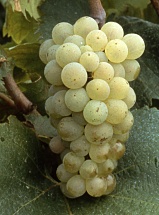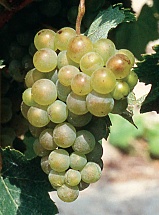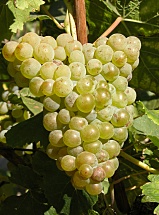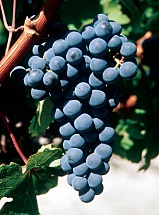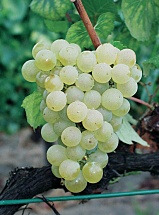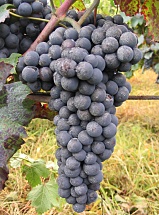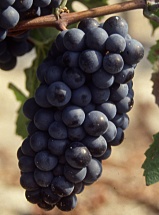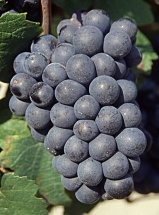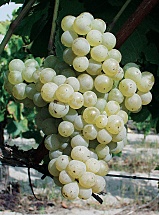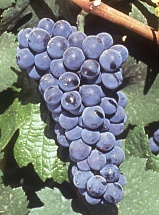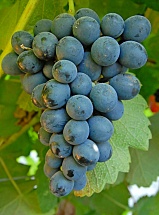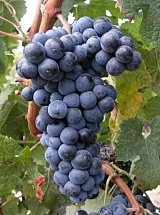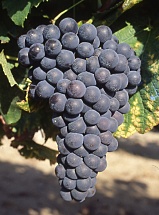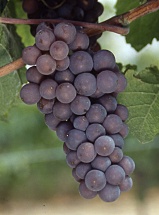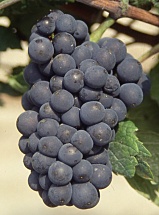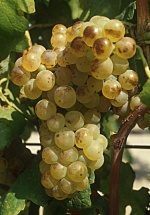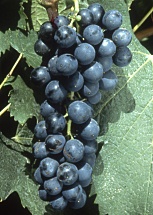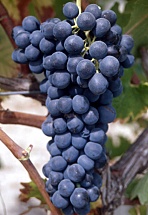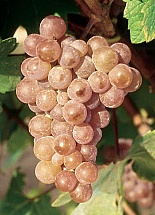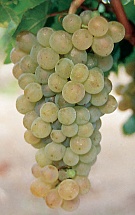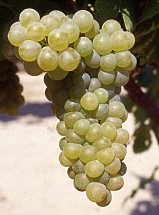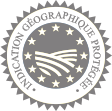Aligoté
Grape certainly from Bourgogne. Genetic analyzes have shown that it is the result of a cross between Gouais blanc and Pinot.
Aligoté is part of vine appellations Bourgogne -Aligoté, Bouzeron, Beaujolais-Villages, Bourgogne Grand ordinaire, Crémant de Bourgogne, Bugey, ...
It gives a lively nervous wine, more or less aromatic and has sometimes a particular character. Drink early in most cases.
Aromas of acacia, lemon, hazelnut, white peach, green apple, grape, vanilla, ...
 Link to the website
Link to the website
 Locate winemakers growing this variety on the map (3)
Locate winemakers growing this variety on the map (3)
Altesse
Savoie native variety but also grown in the Ain and Isère, Altesse grape is called Roussette as well. Ampelographic studies give it a cousinhood with Viognier, Marsanne, Roussanne, or Syrah and Mondeuse.
Altesse is part of vine appellations Bugey, Roussette de Savoie, Roussette du Bugey, Seyssel and Vin de Savoie. It is on the hillsides of Jongieux in Savoy, that gives it its name Marestel the most advanced aromatic expression.
Alone or combined with other grapes (Chardonnay, Mondeuse blanche), it provides two types of wine: either dry white, generous, full-bodied, aromatic, elegant and suited to aging, or soft white, sparkling or effervescent.
 Link to the website
Link to the website
 Locate winemakers growing this variety on the map (10)
Locate winemakers growing this variety on the map (10)
Arvine
It is very present in the Swiss Valais, as well as in the Aosta Valley in Italy. It is a noble grape that used to be grown in Savoy.
Not to be confused with the Sylvaner sometimes called Grande Arvine with no relationship. Based on genetic analyzes published in Switzerland, Arvine would be very close to Chasselas. It is also a related to Grosse Arvine, very few cultivated today.
Arvine gives an elegant wine, full-bodied, manly, very distinctive,, complex and in most cases very balanced, almost always with a saline final grade. Dry, it can be drunk rather young; sweet or liquorous, it has an aging potential of several years.
Aromas of citrus (lemon, grapefruit ...), pineapple, mushroom notes, quince, spices, passion fruit, yellow stone fruits, wisteria blossom, mango, honey, rhubarb, ...
 Link to the website
Link to the website
 Locate winemakers growing this variety on the map (3)
Locate winemakers growing this variety on the map (3)
Cabernet-Sauvignon
Grape widely grown in the Gironde where it would be native. It comes from a cross between Cabernet Franc and Sauvignon Blanc.
It is part of vine appellations Médoc, Graves, Saint-Emilion, Bergerac, Pécharmant, Côtes de Duras, Buzet, Cotes de Provence, Les Baux de Provence, Coteaux d'Aix-en-Provence, ...
Cabernet Sauvignon often brings an interesting tannic structure accompanied with a deep color, usually suited to aging and maturing in wood. Vinified alone, it sometimes lacks fat and roundness.
Aromas of ripe blackcurrant, blackcurrant leaf, dark chocolate, sweet spices, fern, smoke, cherry, blackberry, green pepper, plum, licorice, underbrush, tobacco, truffles, vanilla, violet.
 Link to the website
Link to the website
 Locate winemakers growing this variety on the map (1)
Locate winemakers growing this variety on the map (1)
Chardonnay
A strong presence in Champagne and Bourgogne, it is in Chablis the only cultivated variety. Different genetic analyzes have shown that it is the result of a cross between Gouais blanc and Pinot.
Chardonnay is part of vine appellations Champagne, Saumur, Orléans, Touraine, Vins du haut Poitou, Vins du Thouarsais, Bugey and Vin de Savoie.
It is also highly represented in so-called "new world" countries.
With reasonable yields, it gives a wine of great finesse, well-balanced, powerful, wide and with a strong aromatic potential. Chardonnay also lends itself well to breeding and fermentation in barrels.
In the South of France, it should be harvested early enough to get a high quality product and the balance degree / acidity should be especially monitored.
Chardonnay is a very revealing variety of the soil and climate suitable for both fresh and warm, it will develop very different flavors depending on where it is grown and how it is raised. The following list (not exhaustive ...) is a proof:
Aromas of acacia, almonds, toasted almonds, almond green, amber, hawthorn, banana, fresh butter, brioche, cinnamon, blackcurrant, cherry, mushroom, honeysuckle, wax, lemon, leather, quince, spices, blackcurrant leaf, flower orange, fresh hay, fern, dried fruit, fresh grass, lilac, lily, mango, candied chestnut, spearmint, bread, honey, mousseron, blackberry, hazelnut, toasted hazelnut, buttery notes, peach-stone, orange confit, white nettle, buttered bread, toast, grapefruit, papaya, almond paste, white peach, rose petal, flint, pear, pepper, apple, licorice, flint, undergrowth, elderberry, blond tobacco, lime, toast, truffle, vanilla, verbena, purple, ...
 Link to the website
Link to the website
 Locate winemakers growing this variety on the map (22)
Locate winemakers growing this variety on the map (22)
Corbeau (Douce noire)
Before the phylloxera crisis, Douce noire one met in a region between Vallée de la Saône and Isere, on the banks of the Rhone river from the exit of Switzerland to the junction with the Isere. In Savoy, it represented a very important area and was very often associated with Persian and Mondeuse noire to minimize the acidity and relax their tannins. It could also be found in Côte d'or, Yonne, Charentes, Dordogne, Lot et Garonne. Today, it is almost no more multiplied even though it was listed since 2008 in the Official Catalogue of vine varieties under the name Corbeau. Douce noire has long been confused with Italian Dolcetto nero.
This variety gives a soft wine, lively, with harmonious tannins, slightly alcoholic, ideal to produce a young wine. Part of the grape varieties Vins des Allobroges.
Aromas of red berries, elderberries, violet, ...
 Link to the website
Link to the website
 Locate winemakers growing this variety on the map (3)
Locate winemakers growing this variety on the map (3)
Etraire de la Dui
This variety is native to the Isère valley; it could have been in fact discovered in the Mas de l'Aduïin in Saint-Ismier. One can find some resemblance to Persian, hence its nickname of Gros Persan. Today its nurseries multiplication is very low.
The Etraire is part of the vine appellations Vin de Savoie, where it is grown confidencially.
It gives a tannic wine, dark red with purple reflections, full-bodied, slightly astringent in its infancy but benefits from aging, bouquet with a flavor herbaceous notes.
Aromas of coffee, cassis, cloves, stone fruits (ripe cherries, sour cherries ...), currants, pencil lead, pepper, ...
 Link to the website
Link to the website
 Locate winemakers growing this variety on the map (5)
Locate winemakers growing this variety on the map (5)
Gamay
Typical Burgundian grape. Based on genetic analysis, it comes from a natural cross between Pinot and Gouais.
Gamay is part of the vine appellations Bourgogne, Bourgogne Passe-Tout-Grains, Crémant de Bourgogne, Mâcon, Mâcon supérieur, Beaujolais, Beaujolais supérieur, Beaujolais-Villages, crus du Beaujolais, Anjou, Touraine, Rosé de Loire, Coteaux du Loir, Coteaux du Giennois, Valençay, Châteaumeillant, Coteaux d'Ancenis, Vins du Thouarsais, Côtes d'Auvergne, Saint-Pourçain, Côtes du Forez, Côte Roannaise, Vins de Savoie, Châtillon en Diois, Bugey, Gaillac, Côtes du Marmandais, Lavilledieu, Estaing, Entraygues-Le Fel, Rosé des Riceys, Côtes de Toul, Luberon et de nombreux Vins de Pays.
It gives a wine with a beautiful vivid, intense, clear and bright red. It is clothed in purple, carmine, cherry, scarlet or all shades of ruby. It can also be garnet but never very dark. Often adorned with purple hues.
Aromas of ambergris, ripe banana, English candy, cocoa, cassis, ripe cherry, spice, strawberry, jammy strawberry, raspberry, currant, iris, jasmine, blueberry, blackberry, mineral notes, peppery notes, peony, apple, prune, mignonette, pink, faded rose, truffle, violet.
 Link to the website
Link to the website
 Locate winemakers growing this variety on the map (17)
Locate winemakers growing this variety on the map (17)
Gamay de Bouze
It is a mutation observed by Caumartin in 1823 on a strain of Gamay Noir with white juice. Like other Gamay teinturier, Gamay de Bouze served at a time to color the wine missing color.
It is part of the vine appellations Coteaux d'Ancenis et Touraine.
It gives a medium quality wine, lower than the one produced by the Gamay de Chaudenay and less colorful than the Gamay Fréaux.
 Link to the website
Link to the website
 Locate winemakers growing this variety on the map (1)
Locate winemakers growing this variety on the map (1)
Gamay de Chaudenay
It is a mutation observed by JM Bidault de Chaudenay - Saône et Loire - in 1832 on a Gamay de Bouze strain.
Like other Gamay teinturier, it also served at a time to color the wine missing color.
It is part of the vine appellations Coteaux d'Ancenis et Touraine.
It gives a less colored wine than the one produced by the Gamay Fréaux but with better qualities.
 Link to the website
Link to the website
 Locate winemakers growing this variety on the map (1)
Locate winemakers growing this variety on the map (1)
Jacquère
Grape certainly originally from Savoy and Gouais blanc descending. It is particularly fond of the clay-limestone land with rocky scree.
It is part of the vine appellations Vins de Savoie and Bugey. Jacquère produces a pale wine, light - discreetly floral - bright, acid but with a pleasant freshness, often beading and intended to be consumed young.
 Link to the website
Link to the website
 Locate winemakers growing this variety on the map (20)
Locate winemakers growing this variety on the map (20)
Joubertin
Grape probably originated in Isère department. It can still be found in Savoy, and it is also known in Argentina and Hungary.
Based on genetic analyzes in Montpellier (Hérault), it comes from a natural intraspecific cross between Peloursin and Persan.
It is part of the vine appellations Vin de Savoie for the department of Isère only. It gives a full-bodied wine, neutral, often with good acidity.
It has very long been associated with other grapes, bringing color and balance.
 Link to the website
Link to the website
This grape is not grown now
Mècle
This grape variety was very present once in Isère (Bourgoin region), it is now the subject of a confidential culture.
The mècle gives a solid wine, rich in color and tannins, a bit "stiff" at first, but with a lot of fullness.
 Link to the website
Link to the website
 Locate winemakers growing this variety on the map (1)
Locate winemakers growing this variety on the map (1)
Merlot
Grape originally from the Bordeaux region, it is derived from a cross between Magdeleine noire des Charentes and Cabernet Franc. It is also the half-brother of Côt (or Malbec) but not the black shape of Merlot blanc.
It is part of the red vine appellations of most Vins de Bordeaux, Bergerac, Pécharmant, Côtes de Duras, Buzet, Côtes du Marmandais, Brulhois, Malepère, Cahors, Pineau des Charentes, ... and many Vins de Pays from the South of France.
Its blend with Cabernet franc’s grape must provides more lightness, delicacy and soft and puts it into aquiring faster the properties that must be its share. Merlot noir has a color intensity of two times that Cinsault. Sensitive to oxidation, it must avoid repeated contact with air: it is to be consumed quickly.
Aromas of cherry, leather, spices, jammy strawberry, blackberry, animal notes (venison), plum, apple notes, prunes, liquorice, undergrowth, truffles, violets, ...
 Link to the website
Link to the website
 Locate winemakers growing this variety on the map (2)
Locate winemakers growing this variety on the map (2)
Mondeuse
Cultivated for a long time in Savoie, this is not the black shape of the Mondeuse blanche. Studies show that it comes from a natural intraspecific cross between Mondeuse blanche and Tressot. Recent genetic research have several hypotheses, all of which confirm its close kinship link with Syrah (mondeuse noire is sometimes called " Grosse syrah ").
It is part of the vine appellations Vins de Savoie and Bugey. Gives a solid wine, tannic, colorful, with chewy, very distinctive, aromatic, moderately rich in alcohol, usually with good acidity, bitter at first and suited to aging.
Aromas of cassis, black cherry, spice, fig, strawberry, raspberry, cherry, iris, pepper, plum, black plum, truffle, violet, ...
 Link to the website
Link to the website
 Locate winemakers growing this variety on the map (15)
Locate winemakers growing this variety on the map (15)
Mondeuse blanche
Cultivated for a long time in Savoy, it is not the white form of the Mondeuse noire. It is the mother of Syrah, the father being the Dureza.
It is part of the vine appellations Vin de Savoie and Bugey.
The white mondeuse gives a wine of quality, long-life, rich enough in alcohol and often with good acidity.
 Link to the website
Link to the website
 Locate winemakers growing this variety on the map (3)
Locate winemakers growing this variety on the map (3)
Persan
Its exact origin is not wellknown, but its starting point would seem to be Saint-Jean de Maurienne in Savoie. It was long the dominant grape in the whole valley of the Arc to its junction with the Isere and even to the limits of the department of Drôme.
It can still be found in the Valley of Grésivaudan until Savoie. This variety is very similar to Etraire de la Dui.
The Persan is part of the vine appellations Vins de Savoie and Vins de Pays in the same region.
It provides a quality wine, bouquet, tannic, colorful, rich in alcohol, slightly hard when young but very capable of aging (from 12 to 15 years to reach its fullness).
Aromas of raspberry, violet, ...
 Link to the website
Link to the website
 Locate winemakers growing this variety on the map (9)
Locate winemakers growing this variety on the map (9)
Pinot gris
Grape probably from Burgundy. This is the gray shape of pinot noir; it should be noted that its gray character is not related to its entire genetic code, but only to that of its mutated cell tissue on the periphery of the grapes and thus only the vegetative propagation can propagate this gray character.
Pinot Gris is grown mainly in the Pays de Loire and Alsace where it gives high quality wines, very fine, particularly those from late harvest or selection of noble grapes: Pinot Gris is well suited to an overmaturation of the grapes on strains.
Aromas of apricot, amber, fresh butter, smoked wood, cocoa, cinnamon, ash, mushroom, chanterelles, honeysuckle, beeswax, wheat, white fruit, passion fruit, broom, humus, fresh nutty, honeyed notes, wet straw, grapefruit, burning vines shoots, undergrowth, vanilla, ...
 Link to the website
Link to the website
 Locate winemakers growing this variety on the map (9)
Locate winemakers growing this variety on the map (9)
Pinot noir
Grape probably from Burgundy. Recently, Italian and Swiss researchers hypothesize that Pinot Noir is a great-grandparent of Syrah.
Pinot Noir makes many Burgundy, Champagne or Orléanais appellations famous. It produces a beautiful colored wine, with a pleasant bouquet, which remains long in the mouth and sometimes can be stored for a very long time depending on vintages.
Aromas of hawthorn, banana, heather, cocoa, coffee, cinnamon, black currant, mushroom, cherry, mushroom, chocolate, quince, fresh bread crust, leather, dates, spices, figs, fern, strawberry, jammy strawberry, raspberry, fruit confit, cooked fruit, ripe fruit, clove, cherry, currant, humus, jasmine, mint, blueberry, moss, blackberry, musk, animal notes, cherry stone, carnation, gingerbread, baked peach, pistachio, peony, pepper , pepper, plum, ripe plum, pepper, prunes, ripe grapes, liquorice, mignonette, pine resin, brier rose, faded rose, undergrowth, elderberry, wet earth, truffles, vanilla, venison, violet, ...
 Link to the website
Link to the website
 Locate winemakers growing this variety on the map (14)
Locate winemakers growing this variety on the map (14)
Roussanne
As Marsanne, Roussanne is a native of the Montelimar area in the department of Drôme. It is also found for a long time in the region of Tain l'Hermitage (Drôme) and Saint-Péray (Ardèche). Not to be confused with Var rosé or Var Roussanne, with rose colored berries and is almost no longer multiplied. In Savoy, it takes the name of Bergeron (Chignin).
Roussanne is a noble grape producing wines of high quality, fine, straw-colored, powerful, often with good acidity, a remarkable bouquet and aging very well.
It is part of the vine appellations Hermitage, Vins de Savoie, Crozes-Hermitage, Saint-Péray, Saint-Joseph, Côtes du Rhône, Châteauneuf du Pape, Corbières,...
In combination with other white varieties, Roussanne gives an aromatic supplement and elegance that the latter would not have without it.
Aromas of apricot, hawthorn, green coffee, honeysuckle, honey, discreet narcissus, iris root, ...
 Link to the website
Link to the website
 Locate winemakers growing this variety on the map (6)
Locate winemakers growing this variety on the map (6)
Servanin
Ancient grape that used to be cutlivated in the northern Isère and southern Savoy, it has now almost disappeared from the vineyard. Not to be confused with the Servagnin (synonyms Salvagnin, sauvagnin or servignier), name given in Morges region (Switzerland) to a selection of Pinot noir.
The Servanin is part of vine appellations Vin de Savoie.
It gives a beautiful color of wine, tannic, astringent at first, more or less acid and sometimes poor in alcohol.
 Link to the website
Link to the website
This grape is not grown now
Syrah
It is originated from Rhodanian. Through DNA analysis, a Californian team of researchers and the ENSA-INRA of Montpellier have discovered it is related to Mondeuse blanche (mother) and Dureza (father). Syrah is the aunt or uncle of Teroldego.
It is part of vine appellations Côtes du Rhône, Côte Rôtie, Cornas, Saint-Joseph, Hermitage, Châteauneuf du Pape, Palette, Côtes de Provence, Coteaux d'Aix-en-Provence, Les Baux de Provence, Languedoc, Corbières, Collioure, Côtes du Roussillon, Costières de Nîmes, Banyuls, Maury, Rivesaltes, Gaillac, Fronton,...
It provides high-quality wines, high in alcohol, intense color, very aromatic, fine and complex, tannic, structured and relatively low acids, suitable for aging. This variety allows to elaborate fruity rosés very pleasant to drink.
Aromas of banana, cocoa, cinnamon, black currant, cherry, bitter chocolate, leather, spices (peppery), raspberry, ripe raspberry evolving with time towards notes of pepper, wild raspberry, cooked fruit (prune), blackberry, animal notes (leather and skin), olive, licorice, underbrush, blond tobacco, truffles, violets, ...
 Link to the website
Link to the website
 Locate winemakers growing this variety on the map (3)
Locate winemakers growing this variety on the map (3)
Velteliner rouge précoce
Grape probably originated in northern Italy. It occurs mainly in Austria, Germany, Switzerland, Hungary, Slovakia, ... but also somewhat in France where it is part of vine appellations Vin de Savoie.
It gives a wine with a particular bouquet, generous, bold, pleasant, rich in alcohol, slightly aromatic with a tendency to maderize quickly, usually with medium acidity.
 Link to the website
Link to the website
 Locate winemakers growing this variety on the map (1)
Locate winemakers growing this variety on the map (1)
Verdesse
Ancient grape of Isère department and particularly the valleys of Grésivaudan and Drac, it is sometimes called in Grenoble “Etraire blanche”.
Verdesse is is part of vine appellation Vin de Savoie.
It gives a wine of excellent quality, generous, lively, rich in alcohol, with a special robust but not musky flavor.
Very floral and vegetal aromas.
 Link to the website
Link to the website
 Locate winemakers growing this variety on the map (9)
Locate winemakers growing this variety on the map (9)
Viognier
It is an ancient grape vineyards of Condrieu and Ampuis. It is also found in many South of France Vins de Pays where it is vinified alone in most cases.
Viognier is is part of vine appellations Condrieu, Château Grillet - vinifié seul -, Côte rôtie, Côtes du Rhône,...
It produces high quality wines, fat, soft to the limit of smoothness, very fine, very fragrant, sometimes lacking a good acidity and may sometimes have a slight bitterness. Serve cool but not chilled, as an aperitif or to accompany fish, crayfish, quenelles Lyonnaise or white meat.
Viognier can also be used to develop semi-sparkling or sparkling wines.
Aromas of apricot, oak, honeysuckle, wax, lime, quince, spices, almond blossom, flower hawthorn, dried fruit, toasted, iris, mango, acacia honey with which aging brings a touch of musk , mineral, gingerbread, fish, tobacco, lime, violet, ...
 Link to the website
Link to the website
 Locate winemakers growing this variety on the map (8)
Locate winemakers growing this variety on the map (8)
 Back to the top
Back to the top




